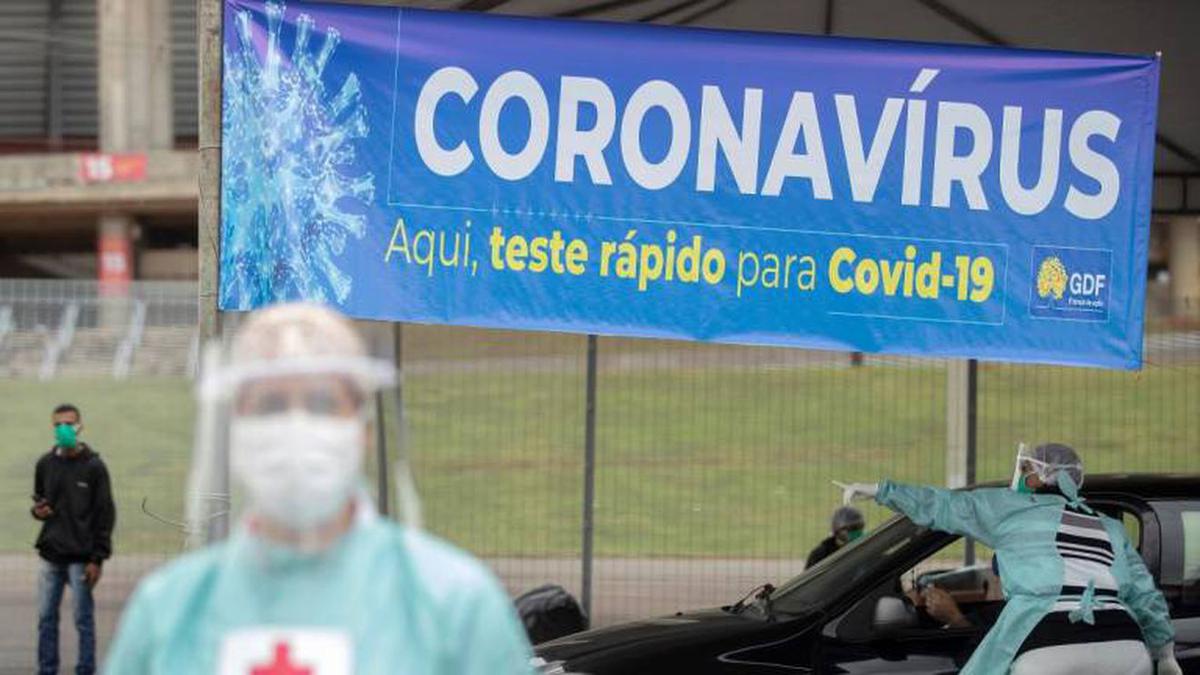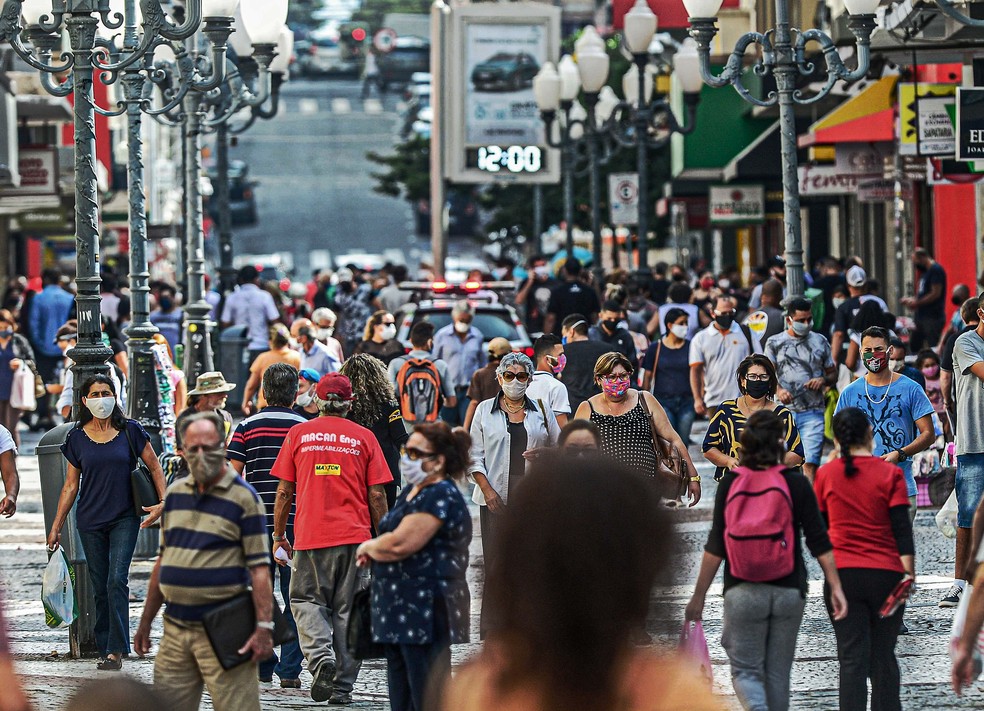RIO DE JANEIRO, BRAZIL – For almost two months the official coronavirus pandemic data suggest evidence of calming in Brazil. The number of deaths reported daily – which for months had stood above the tragic 1,000 mark – now stands at around 500.
But the country continues to see the pandemic spread over its territory at different speeds, and the general downward trend contrasts with the fact that ten Brazilian capitals have shown signs of renewed infection growth in recent weeks, according to Infogripe, a Fiocruz (Oswaldo Cruz Foundation) group that monitors hospital admissions for severe acute respiratory syndrome, corrects notification delays and estimates the likelihood of contagion growth nationwide.
Aracaju, Florianópolis, Fortaleza, João Pessoa, Macapá, Maceió, and Salvador are showing strong indications of this growth, while Belém, São Luís, and São Paulo present moderate signs. This was the first week that São Paulo showed signs that it ceased to decline and could see the contagion grow again.

This increase in hospitalizations – particularly concentrated in Northeastern capitals, one of the first regions to experience the most serious picture of the pandemic in the country – is still far from the demand at the height of the crisis. Since then, the country has closed 65 percent of its ICU spaces open in the emergency and the distancing measures began to be relaxed as cases declined.
But this relaxation, coupled with concern over the movements resulting from the election campaign, has caused some states to again suffer pressure on their health systems, retreating from isolation flexibilization and announcing the reopening of new beds.
Manaus prepares to reopen beds
This is the case in Manaus. The Amazonas capital was one of the first in the country to see its health system collapse because of the coronavirus pandemic. It quickly reached a tragic scenario between April and May and, at the cost of many deaths, assumptions were made that it had reached the desired herd immunity. But this month, infections increased again.
Last weekend, Delphina Aziz Hospital, a standarad for Covid-19 care in the Amazonian capital, announced that it had nearly all of its ICU beds occupied. In addition to the demand for new admissions, the hospital was still facing a peak demand in the pandemic: 60 percent of its 90 ICU beds are occupied by patients who are already free of the virus but still need intensive care due to the sequelae of Covid-19.
The supply of beds in the city is also lower now. In June, when cases dropped, a field hospital with 180 beds, 39 of which ICU beds, was disabled by the Manaus City Hall. The State Government also redistributed Covid-19 beds for the treatment of other diseases given the situation of stability. “The situation is currently being reviewed”, reports the Health Secretariat.
By last Tuesday, 77 percent of the ICU beds and 70 percent of the clinical beds in the state were occupied by patients – the result of an explosion in hospitalizations over the past two weeks. If between July and September the State had an average of 15 daily hospitalizations, the daily demand doubled this month of October. Governor Wilson Lima himself conceded this week that the Amazonas hospital network is under pressure.
“We don’t have any indication of a second wave, but some situations have been occurring and have placed us in a state of alert,” Wilson Lima explained during a press conference last week. He announced the introduction of 42 new ICU beds and a ban on crowds on beaches and resorts to contain a potential acceleration in contagion. But he said he was concerned about the impacts the electoral events and the start of the rainy season could have.
“This whole scenario has caused pressure on the network and made hospitals reach their maximum capacity,” he said. Infogripe’s monitoring places Manaus in a situation of alert. “It appears to be stabilizing, but it has not yet managed to reverse the trend of renewed growth,” explains researcher Marcelo Gomes.

In Greater Florianópolis, private hospitals cancel surgeries
A city classified as of concern is Florianópolis. Gomes explains that the capital of Santa Catarina has been showing signs of growth in hospitalizations for five consecutive weeks. “And it is a very sharp growth,” he adds. According to the State’s classification, Florianopolis is in “serious potential risk”, the second most serious stage on a scale of four designed by the Government.
It has already been at very high risk but dropped a level in the first half of October. The city has 86.83 percent of its ICU beds occupied. In Greater Florianópolis, this rate stands at 74.07 percent. There, the Imperial Hospital de Caridade and Unimed have decided to suspend elective surgeries due to the increase in the number of cases in the region in October. And city halls announce more inspection to contain crowds during the All Saints Day holiday.
Santa Catarina saw its contagion curve grow stronger months after the pandemic hit Brazil and did not close its Covid-19 ICU beds. Now, it is trying to preserve the 724 beds that it managed to enable together with the Ministry of Health until at least the end of this year. These beds represent more than double (127 percent) of the hospital structure that the State had. The Santa Catarina Health Secretariat states that it is monitoring the situation daily to prevent a second wave of infections.
Fortaleza, in Ceará, is another capital that completed five weeks with a growing trend of infections, according to Infogripe’s monitoring. “The Fortaleza curve is a little misleading because the peak was very strong there, with extremely high weekly cases. As it declined nicely, when you look at the rates, it seems that this growth is mild. But it demands great caution,” Gomes points out. The Fortaleza Health Region, which includes the capital and 42 other cities, has recorded an expressive increase in new Covid-19 cases and has 63.64 percent of its ICU beds occupied.
Ceará, currently with 57 percent of its Covid-19 beds filled, is operating with 313 ICU beds. At the peak of the health crisis, it had 911. But according to the Health Secretariat, structures created to expand these beds remain available in case they need to be reactivated. In recent weeks, the increase in cases in some regions of Ceará, including the capital Fortaleza, led Governor Camilo Santana to slow the pace of relaxation of restrictive measures.
He again canceled events in enclosed spaces, which would have been pointed out as an important vector of transmission, given that the most recent data points to more intense infection among people aged between 20 and 39 and, in these events, masks are not commonly worn. The governor has also repeatedly voiced concern over the crowds caused in electoral events.
The pandemic is not over
“The decline process (in the number of cases and deaths by Covid-19) and the flexibilization by states should not be interpreted by the population and health authorities as an irreversible picture, as something gradual towards a return to normality and the end of the pandemic,” argues researcher Marcelo Gomes. He says there is no evidence of herd immunity anywhere in the country and that the Brazilian population is still susceptible to the virus.
Gomes recalls that capitals with a growing trend are in a very different situation from the peak they faced before, but at that time there were more additional beds and field hospitals available. “This is something that should be reassessed by local authorities. To consider the supply and what is needed in order to prepare the infrastructure,” he says.
This is because a second wave is not ruled out – the term has no definition in the epidemiological vocabulary, but it means new growth after a slowdown in the pandemic. Several European countries that had apparently already succeeded in reducing contagion are now experiencing this reality. In recent weeks, Spain has returned to a state of alarm that should be extended until next year, France has resumed confinement, Germany has closed its bars.
But it is difficult to draw comparisons with the Brazilian reality. “We experienced a very sharp growth and a slow decline in many places, with no real low levels. This could imply that the percentage of susceptible people is not as high as in Europe. But it’s not an advantage. It means that we can’t contain the crisis,” Gomes explains.
Doctor Marcio Sommer Bittencourt, from the Clinical Research and Epidemiology Center of the São Paulo University Hospital, says that there are places in Brazil that show a growing trend of the pandemic, but that the data available at the moment are insufficient to establish that there is risk of a new wave of infection. He considers that all the data used to monitor the course of the pandemic has some limitations – from late notification of hospitalization to underreporting of cases and low testing.
“We test less than we should, and several cities show a shift in the curve, but it’s a gradual increase. Compared to the proportion of the first big wave, it’s more controlled,” he notes. Bittencourt believes that the contagion is increasing because of the relaxation of restrictions that have been taken all over the country, but considers that the population remains careful with the wearing of masks and distancing.
“Although the government is ending the distancing measures, the flow is not as it usually is. People don’t all leave home, which causes (the rate of contagion) to occur more slowly”, he says. He argues that the important point is not to determine whether or not Brazil is experiencing a second wave at the moment, nor does he identify a location that is in fact faced with such a sharp resurgence. But he cautions: “If we remain on a lower plateau, we will have one of the worst mortality rates by March next year”.
Source: El País

